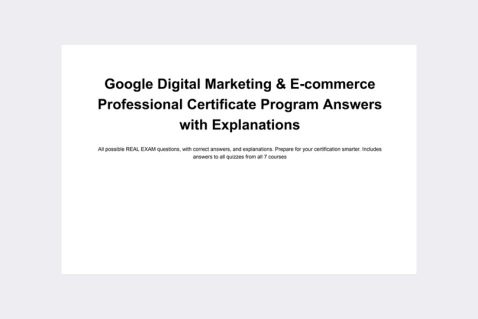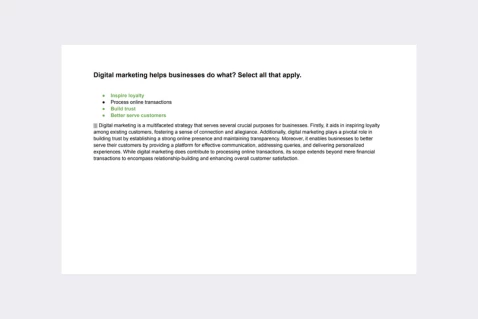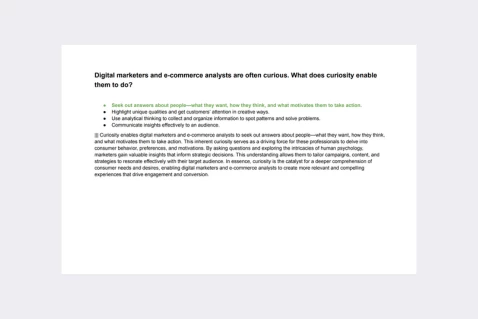Consider the following customer persona: A 38-year-old woman who exercises regularly and does not think that she has enough time to cook meals after work. What component of the customer persona is missing?
Cost
Goal
Barrier
Demographics
Certification program: 👉 Google Digital Marketing & E-commerce Professional Certificate (Coursera)
Explanation: The component missing in the given customer persona is the Barrier. While the persona includes information about age, exercise habits, and time constraints, it lacks insight into the challenges or obstacles (barriers) the individual faces. Understanding barriers is crucial for tailoring marketing strategies to address specific pain points and obstacles that customers may encounter. In this scenario, identifying the barrier could involve exploring the reasons behind the perceived lack of time to cook meals after work. Including barriers in a customer persona provides a comprehensive view of the customer’s needs and challenges, enabling marketers to develop more effective and empathetic solutions in their products or services.
Passing exams is not a workout. Multiple attempts won’t make you stronger.



- All possible certificate program questions
- Real certification exam questions
- Detailed answer explanations.
- Over 1700 questions, 7 courses, 30 quizzes
- Free lifetime updates.
Understanding Customer Personas: What’s Missing?
Customer personas are fictional representations of your ideal customers based on market research and real data about your existing customers. They help businesses better understand their target audience and tailor their marketing efforts to meet their needs and preferences. However, creating an effective customer persona requires careful consideration of various factors. In the scenario provided, a 38-year-old woman who exercises regularly and lacks time to cook meals after work is described. But what component of the customer persona is missing?
Defining Customer Personas
Before delving into what’s missing, let’s first understand the key components of a customer persona:
-
Demographic Information: This includes details such as age, gender, occupation, income level, and marital status. It provides a basic understanding of who the customer is.
-
Psychographic Information: This encompasses lifestyle, interests, values, attitudes, and behaviors. It helps paint a more holistic picture of the customer’s preferences and motivations.
-
Challenges and Pain Points: Identifying the problems or obstacles that the customer faces in their daily life or in relation to your product or service.
-
Goals and Aspirations: Understanding what the customer hopes to achieve or accomplish, both in general and specifically related to your product or service.
-
Buying Behavior: Insights into how the customer makes purchasing decisions, including factors that influence their choices and the channels they prefer.
-
Communication Preferences: Knowing where and how the customer prefers to receive information and interact with brands, such as through social media, email, or in-person interactions.
Identifying the Missing Component
In the given customer persona, we have some valuable information about the individual’s age, lifestyle, and time constraints. However, there’s a crucial element missing: the specific needs and preferences related to meal solutions or food choices.
Practical Insights
To create a more comprehensive customer persona for this scenario, here are some practical insights related to understanding the missing component:
-
Dietary Preferences: Determine if the customer has any dietary restrictions, preferences, or specific nutritional goals. This could include factors such as vegetarianism, gluten-free, low-carb, or keto diets.
-
Cuisine Preferences: Explore the types of cuisines or flavors that the customer enjoys. This could influence the types of meal solutions or recipes that would resonate with them.
-
Convenience vs. Health: Understand the balance between convenience and health considerations for the customer. While time-saving solutions are important, some customers may prioritize health and nutrition over convenience.
-
Meal Occasions: Consider the occasions for which the customer needs meal solutions. Are they looking for quick dinners after work, convenient lunches for the office, or easy breakfast options?
-
Budget Constraints: Take into account the customer’s budgetary constraints and willingness to invest in convenient meal solutions. This could impact the types of products or services they are interested in.
Conclusion
In conclusion, while the provided customer persona offers valuable insights into the individual’s demographics and lifestyle, it lacks specific information about their dietary needs, food preferences, and meal-related challenges. By incorporating these additional details, businesses can create more targeted and effective marketing strategies that resonate with their target audience’s needs and preferences.
Discover our best-value guides
- Special Bundle Offer Google_Ads_Roll
- Special Bundle Offer HubSpot_Exams_Roll
- Special Offer Unchained_Guru_Roll
- Special Bundle Offer Amazon_Roll
- Special Bundle Offer Google_Analytics_Roll
- Special Bundle Offer Google_SkillShop_Roll
- Special Bundle Offer Marketing_Platforms_Roll
- Special Bundle Offer Microsoft_Advertising_Roll
- Special Bundle Offer YouTube_Roll
- Special Bundle Offer Google_Android_Roll
- Ultimate PMP certification preperation guide
- Google Cloud Professional Architect Certification Exam Answers - Ultimate Guide
- Special Bundle Offer SEMrush_Roll